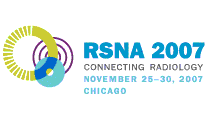
Abstract Archives of the RSNA, 2007
LL-PH6112-B02
Application of Prospective Gating Step and Shoot Scan for Cardiac Imaging in Low and Moderate Heart Rate Patients
Scientific Posters
Presented on November 25, 2007
Presented as part of LL-PH-B: Physics - CT
Kozo Sato MD, Presenter: Nothing to Disclose
Masahiro Jinzaki MD, Abstract Co-Author: Nothing to Disclose
Yoshiyuki Okano, Abstract Co-Author: Nothing to Disclose
Minoru Yamada MS, Abstract Co-Author: Nothing to Disclose
Kosuke Sasaki MS, Abstract Co-Author: Employee, General Electric Company
Sachio Kuribayashi MD, Abstract Co-Author: Research grant, General Electric Company
Chisa Hamaguchi BS, Abstract Co-Author: Employee, General Electric Company
et al, Abstract Co-Author: Nothing to Disclose
et al, Abstract Co-Author: Nothing to Disclose
The prospective gating step and shoot scan was introduced for low dose cardiac imaging. The purpose of this study is to evaluate the application of the prospective gating step and shoot scan for cardiac imaging for low and moderate heart rate patients.
LightSpeed VCT (GE Healthcare, WI) was used in this study. 40 patients (age: 64+/-12, M/F: 32/8) bellow 70bpm underwent the prospective gating step and shoot scan (PSS) with 0.35sec rotation and 64x0.625mm. The exposure time was extended adding the margin called “padding” before and after the exposure of half scan (233msec) to compensate the cardiac phase selection. The padding was set 100msec for HR<60bpm and 200msec for 60≤HR≤70bpm. Optimal phase selection for each patient was classified into end systolic (40-50%) or mid diastolic phase (70-80%). The distribution of the optimal phase was evaluated for patient heart rate. To compare the radiation dose with helical scan, the result of other 40 cases (age: 64+/-11, M/F: 26/14) who underwent the helical scan with retrospective gating (HRS) was reviewed retrospectively. Tube current of PSS and RH was set to image SD 23. Dose Length Product (DLP) reported on operator’s console was used in this comparison.
Average heart rate of PSS cases was 55.0+/-5.5bpm (range: 45 to 70bpm). The number of HR<60bpm cases was 31 cases and 60≤HR≤70bpm was 9 cases. For HR<60bpm cases, MD phase was selected in all cases. For 60≤HR≤70bpm, MD phase was selected in 8/9 cases and ED phase was selected in 1/9case. Using the proposed padding protocol, all cases of PSS were diagnostic. DLP of PSS (404+/-111mGy x cm) was significant lower than DLP of HRS (1322+/-285mGycm) (p<0.05) and the reduction rate was 69.4 %. DLP of 100msec padding was 349+/-60mGycm and DLP of 200msec padding was 493+/-89 Gycm.
Using the proposed padding protocol, the prospective gating step and shoot scan was applicable to bellow 70bpm cases because of margin of cardiac phase selection.
The prospective gating step and shoot scan for cardiac imaging is applicable to bellow 70bpm cases and radiation dose reduces to 70% of cardiac helical scan.
Sato, K,
Jinzaki, M,
Okano, Y,
Yamada, M,
Sasaki, K,
Kuribayashi, S,
Hamaguchi, C,
et al, ,
et al, ,
Application of Prospective Gating Step and Shoot Scan for Cardiac Imaging in Low and Moderate Heart Rate Patients. Radiological Society of North America 2007 Scientific Assembly and Annual Meeting, November 25 - November 30, 2007 ,Chicago IL.
http://archive.rsna.org/2007/5014508.html

